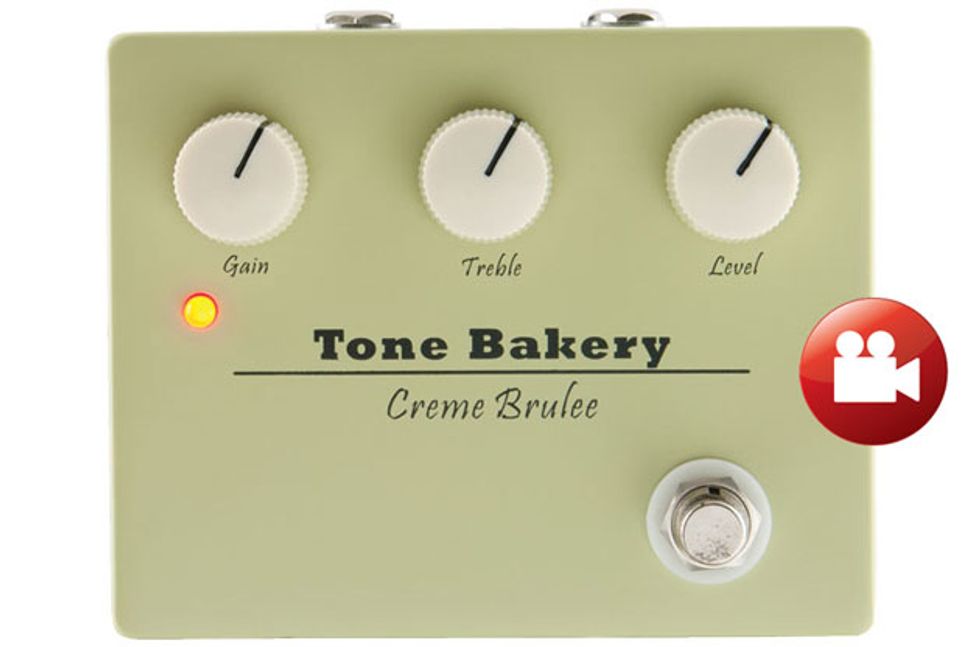No matter how you feel about the Klon Centaur—whether you share the near-religious reverence of its acolytes or simply shrug your shoulders—it’s a damn fine and mighty versatile overdrive. And as with any good (or excruciatingly rare and expensive) pedal, it’s nice to have affordable alternatives.
Tone Bakery’s Creme Brulee doesn’t promise anything apart from being an affordable Klon alternative. But at 99 bucks, it’s very affordable by the near-mad standards of the vintage Klon market. And it delivers much of the Klon’s transparent, near-clean-to-crunchy tones, while offering the responsiveness that spawned the great Klon craving in the first place.
Slightly Secret Sauce
With gain, treble, and level controls aligned along the pedal’s length and an offset footswitch, the Creme Brulee hints unabashedly at the source of its inspiration. Alas, you won’t find out a lot about the Creme Brulee’s components by opening up the back. The upside-down printed circuit reveals even less than the black-tar goop that cloaks the innards of a real Klon. You can, however, see some of the cost saving measures that help Tone Bakery get below the $100 mark, such as board-mounted jacks. We also noticed that the unit can be a bit microphonic and susceptible to switching noise and bumps at high-gain settings, suggesting it could use a little extra shielding somewhere in the circuit.
In general though, economical construction methods have little adverse effect on the unit’s sturdy, solid feel. The knobs turn with a satisfying resistance that allows precise adjustments from the toe of a boot, and they tend to stay in place once you’ve got them where you want them.
Send in the Klones
If you plugged in the Creme Brulee and dialed everything up to noon, you’d probably be pretty pleased with the muscle and dimension it stacks on top of your amplified signal. It’s a fat, full, and natural-sounding overdrive. It’s also a Klon clone, so it was hard to resist playing it alongside the real deal—in this case, Senior Editor Joe Gore’s original (serial number 309 for all you pedal-spotters out there).
How did the Creme Brulee hold up against its near-mythical inspiration? Remarkably well, all told. Perhaps the most important difference is in the pedal’s touch sensitivity. While there’s not a profound difference between the Klon and the Creme Brulee, notes from the Klon tend to jump just a bit more immediately from the amp, and the output from the Creme Brulee feels a touch more compressed at equivalent settings. The difference is subtle, and it’s unlikely to affect the way you interact with the pedal, unless you’re obsessed with technique or a hyper-shredder. (And if that’s the case, why are you looking at a budget overdrive anyway?)
Ratings
Pros:
Super-authentic Klon-style tones on the cheap. Wide range of overdrive colors.
Cons:
Microphonic at high-gain settings.
Tones:
Ease of Use:
Build/Design:
Value:
Street:
$99
Tone Bakery Creme Brulee
tonebakery.com
In fact, were the Creme Brulee not hooked up next to the original Klon, we probably wouldn’t notice any lack of attack at all. It’s sensitive to picking dynamics, and that reactivity is enhanced by an overdriven signal that doesn’t color your guitar’s output too much. Like the Klon, the Creme Brulee possesses a subtlety at low-gain settings that some might classify as transparent—especially when you roll back the gain to near zero. And the ability it gives you to move between wildly different guitars and hear a clear, more-muscular version of each instrument lends a real sense of musical flexibility and dynamism that expands tone and performance possibilities in the studio and on the stage.
Adding gain in small doses colors guitar and amplifier tones with the same airy, wide-spectrum amp-like overdrive that made the Klon intoxicating to so many. And the range of available overdrive shades sometimes feels as colorful and full of possibilities as a box of 64 new Crayolas. Single-coils delivered everything from venomous blues tones to “Taxman”-style Beatle sounds, depending on how you set the very versatile treble control. Humbuckers bristled with cool, compressed, extra high-mid content that lent definition to arpeggios and power chords.
The Creme Brulee’s breadth of character is apparent in higher gain settings too—an application for which Klon’s are less celebrated, perhaps, but at which they are no less capable. The pedal can transform medium-wattage Fenders and 18-watt Marshalls into punky beasts with half-stack-like ferocity. And the snappy picky sensitivity you hear in feel in these zones is intoxicating stuff—particularly if you’ve been binge listening to the works of the young Jimmy Page.
The Verdict
Taken alone, there’s very little downside to the Creme Brulee. Perhaps the most glaring flaw is a lack of shielding that can make the pedal as microphonic as a vintage germanium fuzz at high-gain settings. Then again, the percentage of players who’ll use the Creme Brulee in that way are probably in the minority. That shortcoming aside, the Creme Brulee does a startlingly good imitation of an original Klon, and the slight differences in touch sensitivity, dynamics (the Creme Brulee has a little less), and compression (the Creme Brulee has a little more) are really only perceptible when you play it alongside a vintage Klon. For the rest of us, the Creme Brulee is an excellent overdrive alternative that offers a riot of gritty colors at a very reasonable price.
Watch the Review Demo:








![Rig Rundown: Russian Circles’ Mike Sullivan [2025]](https://www.premierguitar.com/media-library/youtube.jpg?id=62303631&width=1245&height=700&quality=70&coordinates=0%2C0%2C0%2C0)

















